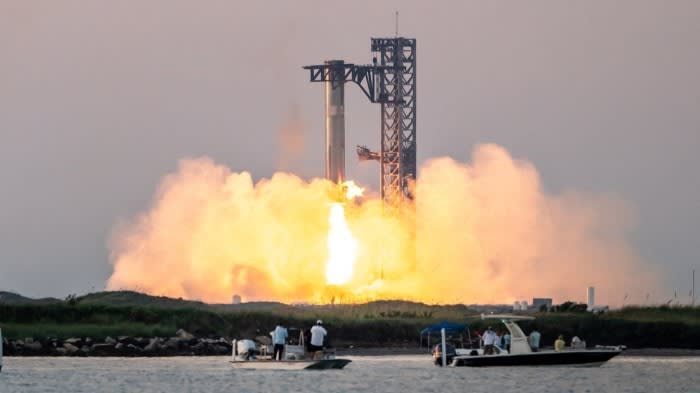Unlock the Editor’s Digest for free
Roula Khalaf, Editor of the FT, selects her favourite stories in this weekly newsletter.
Elon Musk’s SpaceX accomplished a momentous technical feat early on Sunday morning by catching a booster rocket with mechanical arms on its return from a test flight.
At dawn on the Texas coast, SpaceX launched an unmanned Starship rocket with its “super heavy booster”. After a brief flight into the atmosphere, the booster broke away from the Starship and descended vertically, braking its drop with engine blasts.
The booster fell directly back to the launch pad where it was caught by the tower’s metal arms — referred to as “chopsticks” — in a roar of smoke and fire.
“The tower has caught the rocket!!” Musk posted on his social media platform X. “Big step towards making life multiplanetary was made today.”
“Even in this day and age, what we just saw is magic,” SpaceX communications manager Dan Huot said on the company’s webcast. “I am, like, shaking right now.”
The rest of the ship orbited Earth and then splashed down into the Indian Ocean as planned.
Sunday’s flight marks the fifth Starship launch for SpaceX, one of the most valuable private companies in the world. In June, the Starship successfully re-entered Earth’s atmosphere and also splashed down in the Indian Ocean. In September, SpaceX conducted the first privately funded spacewalk for two astronauts.
The successful booster catch is crucial to Starship’s design as a fully-reusable vehicle. Once Starship is operational, SpaceX can make faster trips into space, the company has said. A single Starship flight costs $100mn, Morgan Stanley has estimated, adding that this estimate could eventually drop to $50mn.
SpaceX is preparing for a manned orbit of the moon in 2025 and a moon landing in 2026.

SpaceX was most recently valued at $180bn, which would make it one of the top 50 most valuable companies in the S&P 500 index, Morgan Stanley said in an April report. Its Starlink division has built the world’s biggest satellite network, comprising 2.6mn subscribers.
“We expect Starship to become operational for commercial and government launches in 2027,” the report said. “In 2030 and beyond, we expect all SpaceX launches to be completed by Starship.”
But Sunday’s successful mission came two days after Tesla, Musk’s electric vehicle company, unveiled a “robotaxi” that failed to impress investors. Tesla’s share price is down 13 per cent over the past 12 months.
Musk, the world’s richest man, has become one of Donald Trump’s strongest supporters. The two campaigned together at a rally in Pennsylvania this month.


